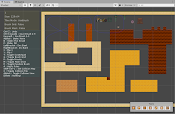
A bit of editor tooling: Tile Editor. OK, there are a lot of tile editing tools out there. Also I have no idea how many of these I have made over the years, on Amiga, ST, DOS, Win32, and even a simple editor on the Megadrive itself! But, this project is about making as much from scratch as possible, and learning a bit of Unity on the way. So, here's the Genesis Tile Map Editor! One of my favourite tile editors was the Rainbow Arts one, on Amiga. Sadly, and surprisingly I can't find any reference to this on the internet! I dont know how we came to use it either. I suspect it was some dodgy hacked copy! Anyway this program used a lot of keyboard shortcuts from DPaint, and so was quick to pick up for anyone in game development in the 90s! It's all based on Brushes. Grab a rectangular brush with B, and place it with your cursor. (while applying any transforms or effects on the way). The other important feature is that of tile rules. This enables us to draw out a basic shape f...

